light AUDI A5 2015 Owner´s Manual
[x] Cancel search | Manufacturer: AUDI, Model Year: 2015, Model line: A5, Model: AUDI A5 2015Pages: 264, PDF Size: 66.83 MB
Page 200 of 264
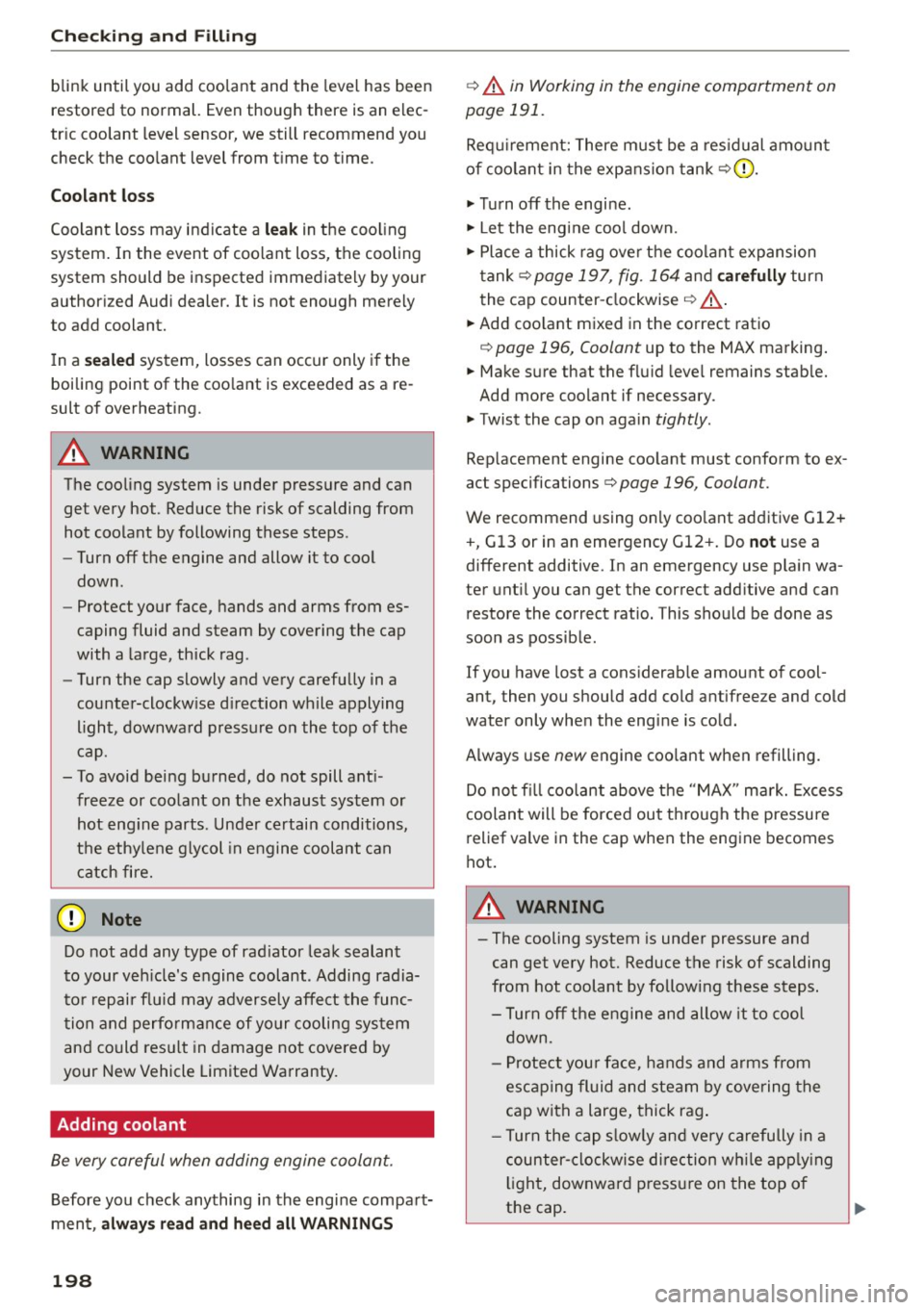
Checking and F ill in g
blink until you add coo lant and the level has been
restored to normal. Even though there is an e lec
tr ic coo lant level sensor, we still recommend you
check the coo lant level from t ime to time.
Coolant los s
Coolant loss may indicate a leak in t he cooling
system. In the event of coolant loss, the cooling
system should be inspected immediately by your
authorized Audi dealer. It is not enough merely
to add coolant.
I n a
s e a led system, losses can occur only if the
boiling point of the coo lant is exceeded as a re
sult of overheating.
A WARNING
The cooling system is under pressure and can
get very hot. Reduce the risk of scalding from
hot coolant by following these steps .
- Turn off the engine and allow it to coo l
down .
- Protect your face, hands and arms from es
caping fluid and steam by covering the cap
with a large, thick rag .
-Turn the cap slowly and very carefully in a
counter-clockw ise d irection while applying
light, downward pressure on the top of the
cap.
- To avoid being burned, do not spill ant i
freeze or coolant on the exhaust system or hot eng ine parts . Under ce rtain conditions,
the ethy lene g lycol in engine coolant can
catch fire.
{il) Note
Do not add any type of rad iator leak sealant
to your veh icle's engine coolant . Adding radia
to r repair f lu id may adverse ly affect the func
tion and performance of your cooling system
and could resu lt in damage not covered by
your New Vehicle Limited Warranty.
Adding coolant
Be very careful when adding engine coolant .
Before you check anything in the engine compart
ment,
alway s re ad an d heed all WARN ING S
198
¢ A in Working in the engine compartment on
page 191.
Req uirement: There must be a res idual amo unt
of coo lant in the expans ion tank
~CD-
.,,. Turn off the engine .
.,,. Let the engine cool down.
.,,. Place a thick rag ove r the coolant expansion
tank
¢ page 197, fig. 164 and car efull y turn
the cap counter-clockwise
~ .&_ .
.,,. Add coo lant mixed in the correct ratio
~ page 196, Coolant up to the MAX marking .
.,,. Make sure that the flu id level remains stab le.
Add more coolant if necessa ry .
.,,. Twist the cap on aga in
tightly .
Replacement engine coo lant must conform to ex
act specifications ¢
page 196, Coolan t.
We recommend using only coo lant additive Gl2 +
+ , Gl3
or in an emergency Gl2+. Do not use a
different additive. In an emergency use plain wa
ter unt il you can get the correct additive and can
restore the correct ratio. This should be done as
soon as possible .
If you have lost a considerab le amount of cool
ant, then you should add cold antifree ze and cold
water only when the engine is cold.
Always use
new engine coo lant when refilling.
Do not fil l coolant above the "MAX " mark. Excess
coolant will be forced out through the pressure
relief valve in the cap when the engine becomes
hot.
A WARNING
- The cooling system is under pressure and
can get very hot. Reduce the risk of scalding
from hot coolant by following these steps.
- Turn off the eng ine and allow it to coo l
down.
- Protect you r face, hands and arms from
escaping fluid and steam by covering the
cap with a large, thick rag .
- Turn the cap s low ly and ve ry carefully in a
counter-clockw ise direction wh ile app ly ing
li ght, downward p ressu re on the top o f
the cap. ..,,.
Page 201 of 264
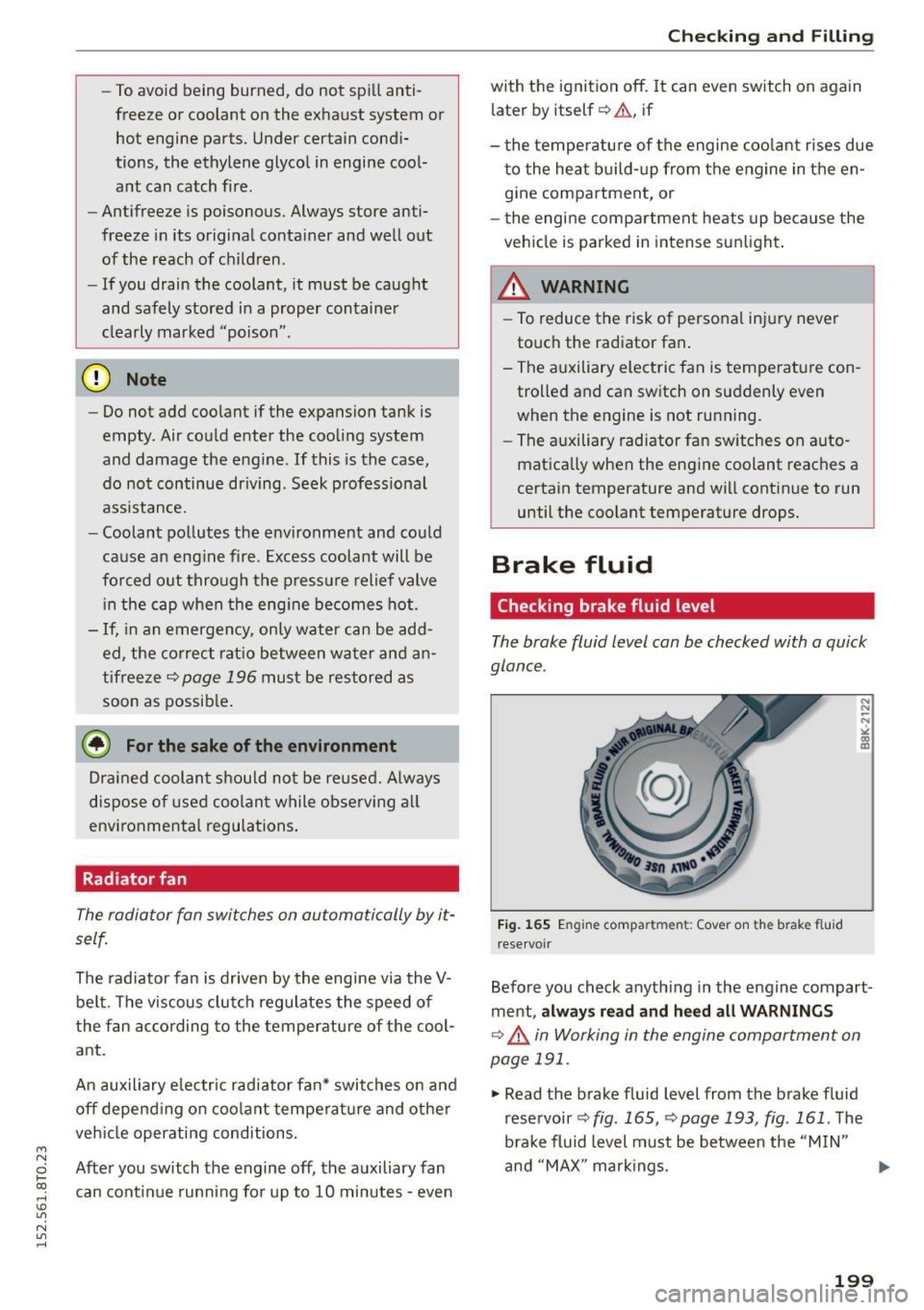
M N
0 loo
rl I.O
"' N
"' rl
-To avoid being burned, do not spi ll anti
freeze or coolant on the exhaust system or hot engine parts. Under certain condi
tions, the ethylene glycol in engine cool ant can catch fire.
- Antifreeze is poisonous. Always store anti
freeze in its original conta iner and well out
of the reach of ch ildren .
-If you drain the coolant, it must be caught
and safely stored in a proper container
clearly marked "poison" .
(D Note
-Do not add coolant if the expansion tank is
empty . Air could enter the cooling system
and damage the eng ine .
If this is the case,
do not continue driving. Seek profess ional
ass istance.
- Coolant pollutes the env ironment and could
cause an eng ine fire . Excess coolant will be
fo rced out through the pressure relief valve
i n the cap when the eng ine becomes hot.
- If, i n an emergency , only water can be add
ed, the correct ratio between wa ter and an
tifreeze
i::;, page 196 must be restored as
soon as possib le .
@) For the sake of the environment
Drained coolant should not be reused. Always
dispose o f used coolant while observ ing all
environmental regulations .
Radiator fan
The radiator fan switches on automatically by it
self.
The radiator fan is driven by the engine via the V
be lt . The viscous clu tch regulates the speed of
the fan ac cording to the temperature of the cool
ant.
An auxiliary e lectr ic rad iator fan* switches on and
off depend ing on coolant temperat ure and othe r
veh icle operati ng conditions.
Afte r you switch the engine off, the auxiliary fan
can continue runn ing for up to 10 minutes -even
Ch eck in g and Fillin g
with the ignition off . It can even sw itch on again
later by itself¢& , if
- the temperatu re of the engine coo lant rises due
to the heat build- up from the engine in the en
gine compartment, or
- the engine compartment heats up because the
veh icle is parked in intense sun light .
A WARNING
-To reduce the risk of persona l injury never
touch the radiator fan .
- The auxiliary electric fan is temperature con trolled and can switch on suddenly even
when the engine is not running.
- The a uxiliary radiator fan sw itches on auto
matica lly when the engine coolant reaches a
certain temperature and will continue to run
until the coolant temperature drops.
Brake fluid
Checking brake fluid level
The brake fluid level can be checked with a quick
glance .
Fig. 1 65 Engine compar tment : Cove r on the b rake fl uid
r e servoir
Before you check anyth ing in the engine compart
ment,
al way s read and h eed all WARNIN GS
¢ _.& in Working in the engine compartment on
page 191 .
.,. Read the brake fluid level from the b rake fluid
reservoir
¢ fig. 165, ¢page 193, fig . 161 . The
brake fluid level must be between the
"MIN "
and "MAX " markings.
19 9
Page 202 of 264

Checking and F ill in g
The brake fluid reservoir is located at the rear
partition of the engine compartment on t he left
side
c!,> page 193.
The fl uid level may drop slightly after some time
due to the automatic adjustment of the brake
pads. This is not cause for alarm.
If the b ra ke fluid level fal ls considerably below
the "MIN" mark, the brake warn ing/indicator
light (U.S. models:
1111 , Canadian models: . )
will come on
c!,> page 15 . Do not contin ue to oper
ate the vehicle . The complete brake system
should be thoroughly checked by an author iz ed
Aud i dealer or qualified workshop and the cause
corrected . If the brake fluid level is too low, the
brake warning/ind icator light w ill illuminate .
Contact an authorized Audi dealer
i mmed iately .
{D) Tips
The brake fluid reservoir is located under
neath the cove r.
Changing brake fluid
Have the brake fluid changed by an experienced
technician .
Brake fluid absorbs moist ure from the a ir. If the
water content in the brake fluid is too high, cor rosion in the brake system may result after a peri
od of time . The boiling point of the brake flu id
w ill also decrease conside rably and dec rease
b rak ing perfo rmance.
Therefore, the brake flu id must be changed
e ve ry
two year s.
Always use new brake fluid w hich con
forms to Fede ral Motor Vehicle Standard "FMVSS
1 16 DOT 4".
The brake fluid rese rvoir can be difficult to reach,
therefo re , we recommend that you have the
b rake fluid changed by your author ized
Audi
dealer .
Your dealer has the correct too ls , the
right brake fluid and the know-how to do t his for
you.
A WARNING
- B rake fluid is poisonous. It must be stored
on ly in the closed original container out of
the reach of children!
200
- Brake fail ure can resu lt from o ld or inappro
priate brake fluid. Observe these precau
tions:
- Use only b rake fluid that meets SAE spec i
f ica tion
J 170 3 and conform s to Federa l
Motor Vehicle Standard 116. Always check
with yo ur autho rized Audi dea le r to make
su re you are using the correct brake fl uid.
The correct type of brake flu id is also ind i
cated on the brake fluid reservoir.
- The brake fl uid must be new. Heavy use of
the brakes can cause a vapor lock if the
brake f luid is left in the system too long.
This can seriously affect the efficiency of
the brakes as well as your safety. This
could result in an acc ident.
(D Note
Brake fluid will damage the paint of your vehi
cle.
@ For the sake of the env ironment
Because of the prob lem of prope r disposal of
brake fluid as well as the special tools re
qu ired and the necessary expert ise, we rec
omme nd that you have the brake flu id
changed by you r autho rized Aud i dea le r.
Battery
, General information
U nder normal operating conditions, the battery
i n your Audi does not need any maintenance.
Wi th
high outside temperatures or long daily
drives we recommend that you have the e lectro
lyte level checked by an a uth orized Aud i deale r o r
qualified workshop . The electrolyte leve l should
a lso be checked each time the batte ry is c ha rged
c:!,> page 202.
Have the battery checked when yo u take your ve
hicle in for service . You a re well adv ised to re
pla ce a battery that is older tha n 5 years.
With certain types of airbag deployment, the bat
te ry is disconnected from the veh icle elect rical
system for safety reasons
c:!,> & in Repair, care
and disposal of the airbags on page 1 42.
Page 203 of 264
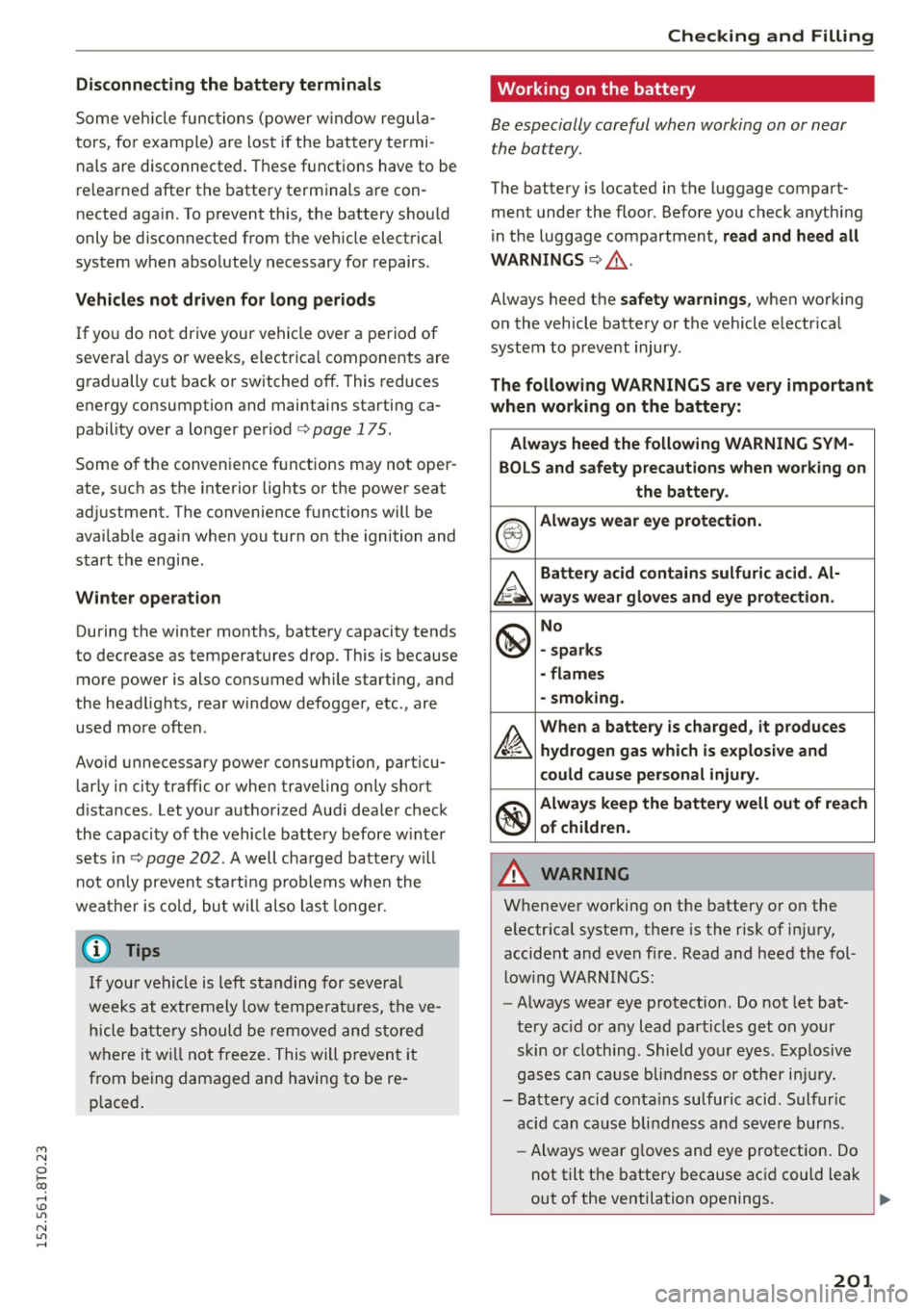
M N
i? co ,...., \!) 1.1'1
N 1.1'1 ,....,
Disconnecting the battery terminals
Some vehicle functions (power window regula
tors , for example) are lost if the battery termi
nals are disconnected. These functions have to be
re learned after th e battery terminals are con
nected again. To prevent this, the batte ry should
only be disconnected from the ve hicle electrical
system when absolutely necessary for repairs.
Vehicles not driven for long periods
If you do not drive your vehicle over a period of
several days or weeks, e lectrica l components are
gradually cut back or switched off. This reduces
energy consumption and maintains starting ca pability over a longer period
c:> page 175 .
Some of the conven ience functions may not oper
ate, such as the interior lights or the power seat
adjustment. The convenience functions will be
available aga in when you turn on the ignition and
start the engine.
Winter operation
During the winter months, battery capacity tends
to decrease as temperatures drop. This is because
more power is also consumed while s tart ing, and
the headlights, rear window defogger, etc ., are
used more often .
Avoid unnecessary power consumption, part icu
larly in city traffic or when traveling only short
d istances . Let your authorized Aud i dealer check
the capacity of the vehicle battery before w inter
sets in ¢
page 202 . A well charged battery will
not only prevent starting problems when the
weather is cold, but will also last longer.
(D Tips
If your vehicle is left standing for severa l
weeks at extremely low temperatures, the ve
hicle battery should be removed and stored
where it will not freeze. This will prevent it
from being damaged and having to be re placed.
Checking and Filling
Working on the battery
Be especially careful when working on or near
the battery.
The battery is located in the luggage compart
men t under the floor. Before you check anything
in the luggage compartment ,
read and heed all
WARNINGS
c:> .&_ .
Always heed the safety warnings, when working
on the vehicle battery or the vehicle electr ical
system to prevent injury .
The following WARNINGS are very important
when working on the battery :
Always heed the following WARNING SYM-
BOLS and safety precautions when working on
the battery.
®
Always wear eye protection.
A
Battery acid contains sulfuric acid. Al-
ways wear gloves and eye protection.
@
No
- sparks
- flames
- smoking.
~
When a battery is charged, it produces
hydrogen gas which is explosive and
could cause personal injury.
®
Always keep the battery well out of reach
of children.
A WARNING
= -
Whenever working on the battery or on the
e lectr ical system, there is the risk of injury,
accident and even f ire. Read and heed the fol
lowing WARNINGS:
- Always wear eye protection . Do not let bat
tery ac id or any lead particles get on your
skin or clothing. Shield your eyes. Exp losive
gases can cause blindness or other in jury.
- Battery acid conta ins sulfuric acid . Sulfuric
acid can cause blindness and severe burns.
- Always wear g loves and eye protection. Do
not tilt the battery because acid could leak
out of the ventilation openings. ...,
201
Page 204 of 264
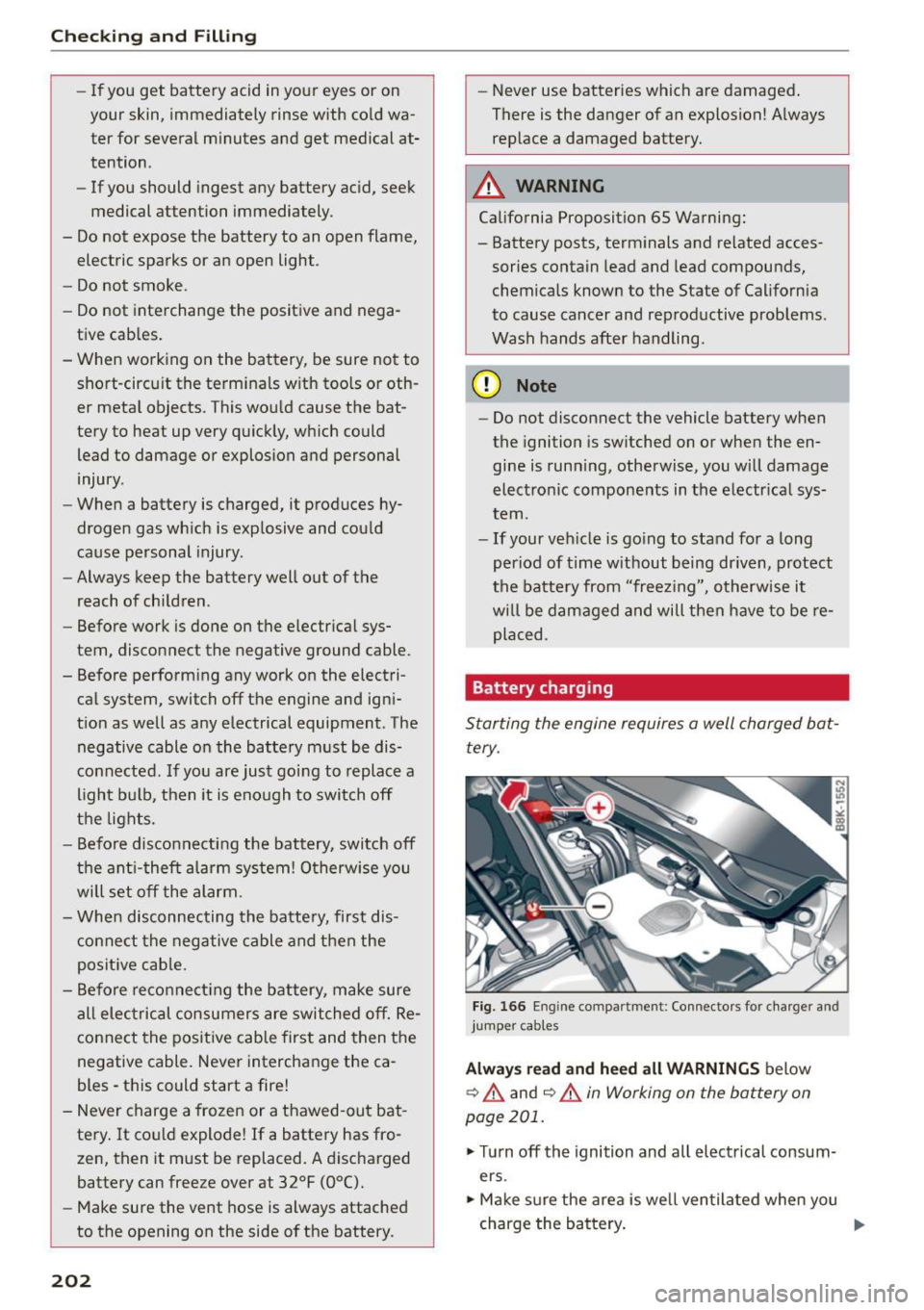
Checking and Filling
-If you get battery acid in your eyes or on
your skin, immediately rinse with cold wa
ter for several minutes and get medical at
tention .
- If you should ingest any battery acid, seek
medical attention immediately .
- Do not expose the battery to an open flame, electric sparks or an open light .
- Do not smoke .
- Do not interchange the positive and nega-
tive cables.
- When working on the battery , be sure not to
short-circuit the terminals with tools or oth
er metal objects . This would cause the bat
tery to heat up very quickly, which could lead to damage or explosion and personal
injury .
- When a battery is charged, it produces hy
drogen gas which is explosive and could
cause personal injury.
- Always keep the battery well out of the
reach of children .
- Before work is done on the electrical sys
tem, disconnect the negative ground cable .
- Before performing any work on the electri cal system, switch off the engine and igni
tion as well as any electrical equipment. The negative cable on the battery must be dis
connected. If you are just going to replace a
light bulb, then it is enough to switch off
the lights.
- Before disconnecting the battery, switch off
the anti-theft alarm system! Otherwise you
will set off the alarm.
- When disconnecting the battery, first dis
connect the negative cable and then the
positive cable.
- Before reconnecting the battery, make sure
all electrical consumers are switched off. Re
connect the positive cable first and then the
negative cable. Never interchange the ca
bles -this could start a fire!
- Never charge a frozen or a thawed-out bat
tery. It could explode! If a battery has fro ·
zen, then it must be replaced. A discharged
battery can freeze over at 32°F (0°C).
- Make sure the vent hose is always attached
to the opening on the side of the battery .
202
-Never use batteries which are damaged.
There is the danger of an explosion! Always
replace a damaged battery.
A WARNING
California Proposition 65 Warning:
- Battery posts, terminals and related acces
sories contain lead and lead compounds,
chemicals known to the State of California
to cause cancer and reproductive problems .
Wash hands after handling .
(D Note
- Do not disconnect the vehicle battery when
the ignition is switched on or when the en
gine is running, otherwise, you will damage
electronic components in the electrical sys
tem .
-If your vehicle is going to stand for a long
period of time without being driven, protect
the battery from "freezing", otherwise it
will be damaged and will then have to be re
placed .
Battery charging
Starting the engine requires a well charged bat
tery.
Fig. 166 E n g in e compar tmen t: C on nectors fo r charger and
jump er cables
Always read and heed all WARNINGS below
9 A and ¢ A in Working on the battery on
page 201.
.,. Turn off the ignition and all electrical consum
ers.
.,. Make sure the area is well ventilated when you
charge the battery.
Iii>-
Page 206 of 264
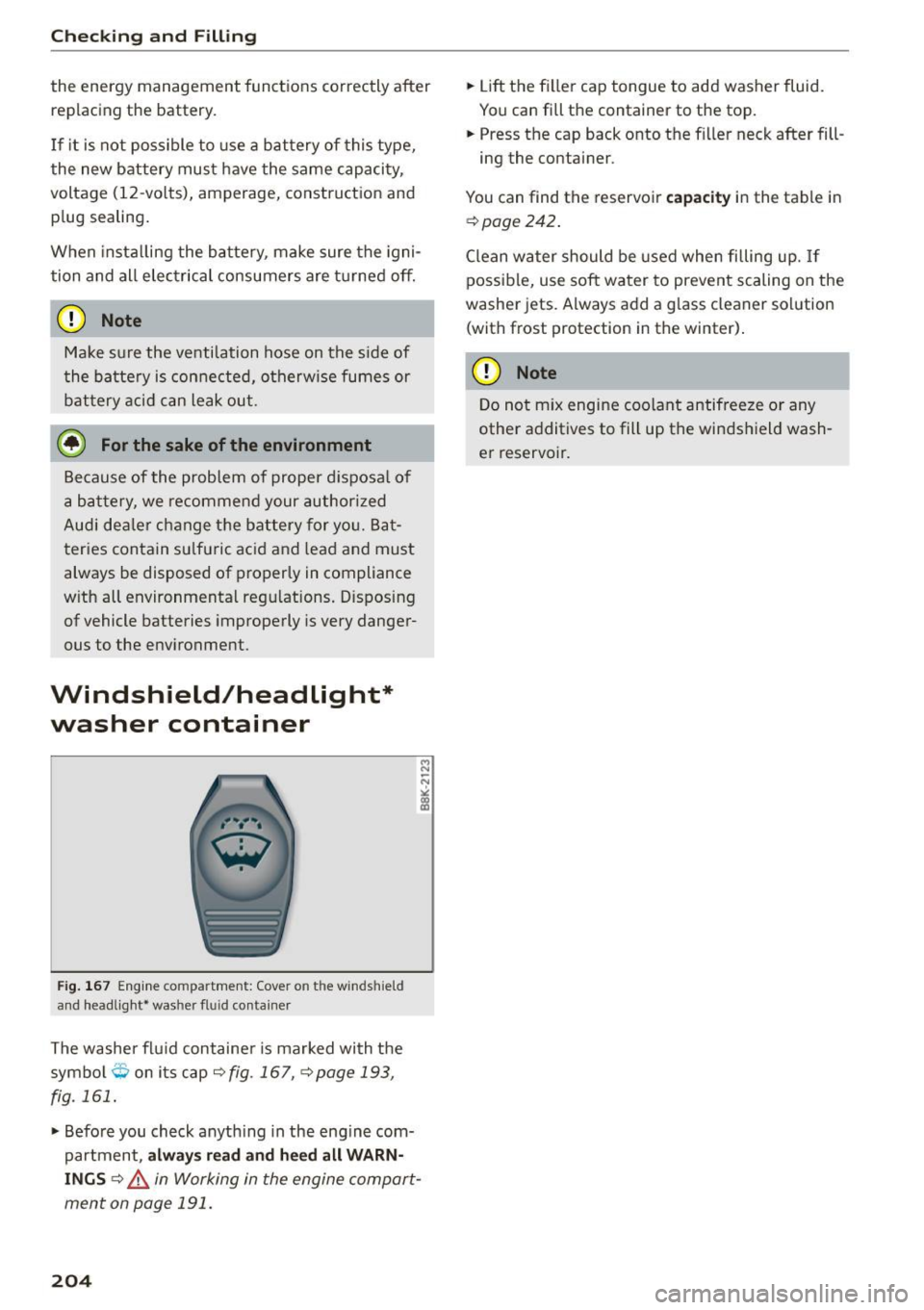
Checking and Fill in g
th e e nergy management functions correctly after
replacing the battery.
If i t is not poss ible to use a battery of this type,
the new battery must have the same capacity,
voltage (12-vo lts), amperage, construct ion and
p lug sealing.
When insta lling the battery, make sure the igni
tion and all elec trical consumers are t urned off.
CD Note
Make sure the ventilation hose on the s ide of
t he batte ry is connected, otherwise fumes or
bat tery ac id can leak out.
@ For the sake of the environment
Because of the problem of proper d isposa l of
a battery, we recommend your author ized
Audi dea le r change the battery for yo u. Ba t
teries contain su lfuric acid and lead and must
always be disposed of properly in compliance
w ith all environmenta l reg ulations. D isposing
of vehicle batteries improperly is very danger
ous to the environment.
Windshield/headlight* washer container
Fig. 167 Engine co mpa rtment : Cove r on th e w in d shiel d
an d h ead ligh t• was her fl uid container
The washer fluid containe r is marked with the
symbol
O on its cap ¢ fig . 167 , ¢page 193 ,
fig . 161 .
.,. Before you check anyth ing in the eng ine com
partment , alw ays re ad and he ed all WARN·
I NGS
¢ ,& in Working in the engine comport
ment on page 191 .
204
.,. Lift the filler cap tongue to add washer fluid.
Yo u can fill the container to the top.
.,. Press the cap back onto the filler neck after fill-
ing the container .
You can find the reservoir ca p acit y in the table in
~ page 242.
Clean water should be used when filling up. If
possible, use soft water to prevent scaling on the
washer jets . Always add a g lass cleaner solution
(with frost protection in the winter) .
CD Note
Do not mix engine coolant antifreeze or any
other additives to fill up the windsh ield wash
er reservoir.
Page 207 of 264
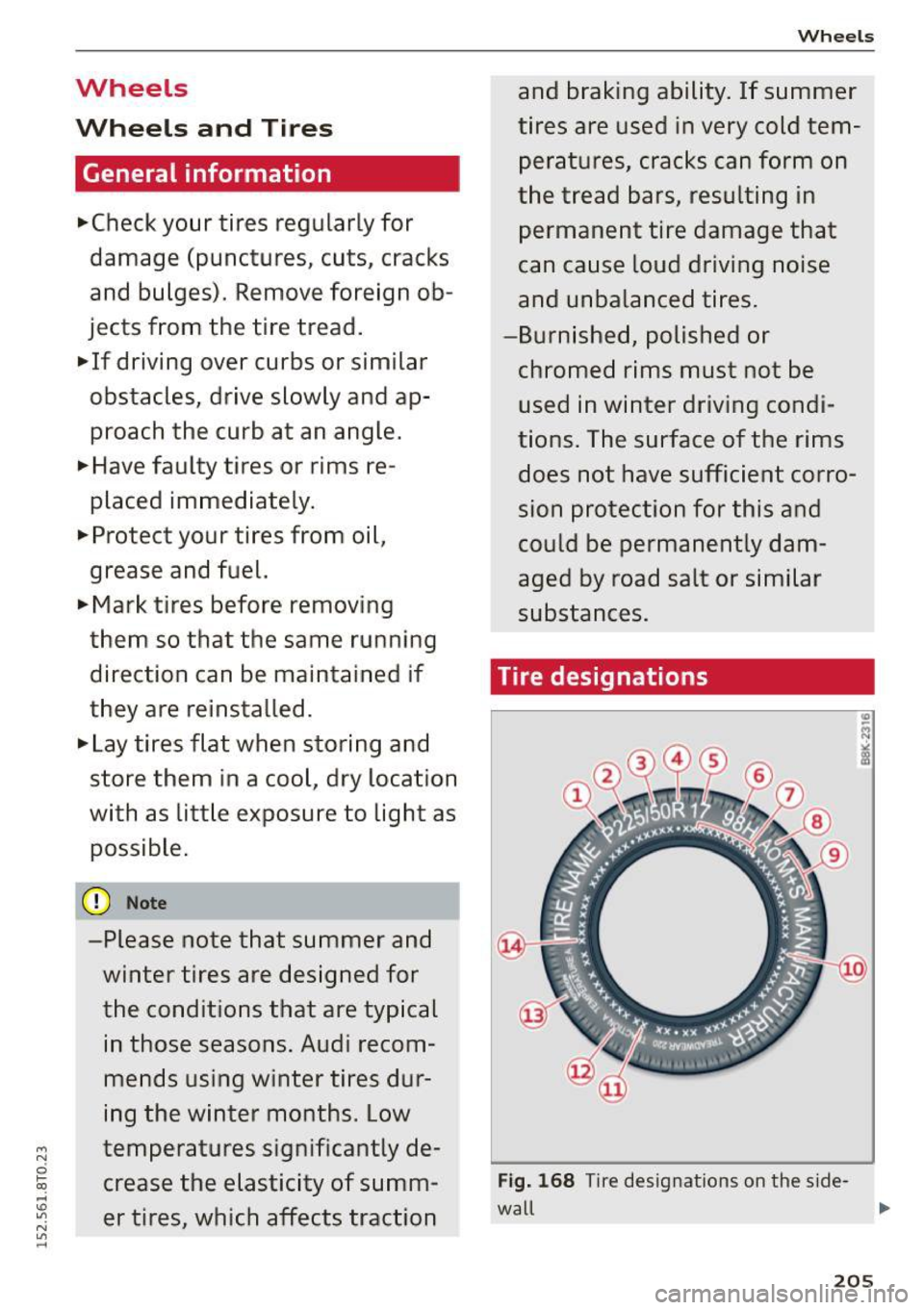
Wheels
Wheels and Tires
General information
.,.Che ck your tires regularly for
damage (punctures, cuts, cracks
and bulges). Remove foreign ob
jects from the tire tread.
.,. If driving over curbs or similar
obstacles, drive slowly and ap
proach the curb at an angle.
.,.Have faulty tires or rims re
placed immediately.
"'Protec t your tires from oil,
grease and fuel.
.,.Ma rk tires before removing
them so that the same running direction can be maintained if
they are reinstalled .
.,.Lay tires flat when storing and
store them in a cool, dry location
with as little exposure to light as
possible.
(D Note
-Please note that summer and
winter tires are designed for
the conditions that are typical
in those seasons. Audi recom
mends using winter tires dur
ing the winter months. Low
temperatures significantly de crease the elasticity of summ
er tires, which affects traction
Wheels
and braking ability. If summer
tires are used in very cold tem
peratures, cracks can form on
the tread bars, resulting in
permanent tire damage that
can cause loud driving noise
and unbalanced tires.
-Burnished, polished or
chromed rims must not be
used in winter driving condi
tions. The surface of the rims
does not have sufficient corro
sion protection for this and
could be permanently dam
aged by road salt or similar
substances.
Tire designations
Fig. 168 T ir e designations on the sid e-
wall ,..
205
Page 225 of 264

also reduces fuel efficiency and tire tread life,
and may affect the vehicle's handling and stop
ping ability .
Please note that the TPMS is not a substitute for
proper tire maintenance, and it is the driver's re
sponsibility to maintain correct tire pressure,
even if under-inflation has not reached the level
to trigger illumination of the TPMS low tire pres
sure telltale.
Your vehicle has also been equipped with a TPMS malfunction indicator to indicate when the sys
tem is not operating properly. The TPMS mal
function indicator is combined with the low tire pressure telltale . When the system detects a
malfunct ion, the telltale will flash for approxi
mately one minute and then remain continuously
illuminated. This sequence will continue upon
subsequent veh icle start-ups as long as the mal
function exists.
When the malfunction indicator is illuminated,
the system may not be able to detect or signal
low tire pressure as intended. TPMS malfunctions
may occur for a variety of reasons, including the
installation of replacement or alternate tires or
wheels on the vehicle that prevent the TPMS
from functioning properly. Always check the
TPMS malfunction telltale after replacing one or more tires or wheels on your vehicle to ensure
that the replacement or alternate tires and
wheels allow the TPMS to continue to function properly.
Wheels
If the Tire Pressure Monitoring System
indicator appears
Appl ies to vehicles : wi th t ir e p ress ure mo nito rin g system
The tire pressure indicator in the instrument
cluster informs you if the tire pressure is too low
or if there is a system malfunction.
Fig. 172 Instrument cluster: i ndicator light with message
Using the ABS sensors, the tire pressure monitor
ing system compares the tire tread circumference
and vibration characteristics of the individual
tires .
If the pressure changes in one or more
tires, this is indicated in the instrument cluster
display with an indicator light
[I] and a message .
If only one tire is affected, the location of that
tire will be indicated .
The tire pressures must be stored in the Infotain
ment system again each time the pressures
change (switching between partial and full load
pressure) or after changing or replacing a tire on
your vehicle ¢
page 224. The tire pressure moni
toring system only monitors the tire pressure you have stored. Refer to the tire pressure label for
the recommended tire pressure for your vehicle
r=> page215, fig.171.
Tire tread circumference and vibration character
istics can change and cause a tire pressure warn
ing if:
- the tire pressure in one or more tires is too low .
- the tire has structural damage.
- the tir e was replaced or the tire pressure was
changed and it was not stored ¢
page 224.
-the spare t ire* is installed.
Indicator lights
[I] Loss of pressure in at least one tire¢.& .
Check the tires and replace or repair if necessary .
liJJ,-
223
Page 226 of 264

Wheels
Check/correct the pressures of all four tires and
store the pressure again in the Infotainment sys
tem
c!) page 224.
mm (Tire Pressure Monitoring System) Tire pres
sure: System malfunction!.
If m appears after
switching the ignition on or while driving and the
[I] i ndicator light in the instrument cluster
blinks for approximately one minute and then
stays on, there is system malfunction. Try to
store the correct tire pressures
c:> page 224 . If
the indicator light does turn off or turns on again
after a short period of time, drive to your author
ized Audi dealer or qualified repair facility imme
diately to have the malfunction corrected.
A WARNING
-If the tire pressure indicator appears in the
display, reduce your speed immediately and
avoid any hard steering or braking maneu
vers. Stop as soon as possible and check the
tires and their pressure.
- The driver is responsible for maintaining the
correct tire pressure. You must check the
tire pressure regularly.
-Under certain conditions (such as a sporty
driving style, winter conditions or unpaved
roads), the tire pressure monitoring system
indicator may be delayed.
- Do not use run-flat tires on your vehicle. Us
ing them when not permitted can lead to
vehicle damage or accidents.
(D Tips
- The tire pressure monitoring system can al
so stop working when there is an ESC mal
function.
- Using snow chains may result in a system
malfunction.
- The tires with the identification "AO" or
"RO"
c:> page 212 have been matched with
your Audi tire pressure monitoring system.
We recommend that you use these tires.
224
· Storing tire pressures
App lies to vehicles: wit h tire press ure mo nitor ing system
If the tire pressure changes or a tire is replaced,
it must be confirmed in the Infotainment sys
tem .
.,. Make sure before storing that the tire pressures
of all four tires meet the spec ified values and
are adapted to the load
c!) page 215.
.,. Switch the ignition on.
.,. Select: the
I CARI function button > Tire pres
sure monitoring
control button. Or
.,. Select: the
I CARI function button > Car Sys
tems*
control button > Servicing & checks >
Tire pressure monitoring.
(D Tips
Do not store the tire pressures if snow chains
a re i nsta lied.
Page 227 of 264

M N
0 loo
rl I.O
"' N
"' rl
Emergency assistance
Vehicle tool kit
The tools ore stored underneath the floor panel
in the luggage comportment.
Fig. 173 Luggage compartme nt: tool kit
When you need access to the veh icle tool kit or
jack*, you will need to take out the spare t ire*
and cover¢
page 225.
The vehicle tool kit includes:
- Hook for removing wheel covers*
- Plastic hook to remove wheel bolt covers*
- Alignment pin for changing the whee l
- Screwdriver w ith reversible blade
- Tool for chang ing light bulbs
- Reversible bit (reversible Torx bit for changing
light bulbs)
- Rod for jack
- Jack*
- Lug wrench
- Towing eye
Some of the vehicle items listed above are prov id
ed on certain models only or are optional extras.
Before returning the jack* to its place, retract the
jack arm fu lly.
_& WARNING
- Never use the screw driver hex head to
t ighten whee l bolts, since the bolts cannot
attain the necessary tightening torque if you
use the hex head, potentially causing an ac
cident.
- The factory-suppl ied jack is intended only
for your vehicle model. Under no c ircum
stances should it be used to lift heavy
Emergen cy assistance
vehicles or other loads; you risk injuring
yourself.
- Never start the engine when the vehicle is
raised, which could cause an accident.
- Support the vehicle securely with appropri
ate stands if work is to be performed under
neath the vehicle; otherwise, there is a po
tential risk for injury.
Space-saving spare tire
(compact spare tire)
Applies to vehicles: with space-saving spare tire
The spore tire/wheel is located in the luggage
comportment under the cargo floor cover. It is
intended for short-term use only.
Fig. 174 Spare tire
Removing the spare tire
.,. Lift the cargo floor by the p lastic handle
¢fig. 174.
.,. Hook the handle into the luggage compart
ment weather strip.
., Turn the large screw ¢
fig. 174 counter-clock
wise.
., Take out the spare ti re .
., Always store the vehicle tool kit, the jack*, and
the replaced tire in the luggage compartment
¢page 118.
.,. Unhook the cargo floor before closing the rear
lid.
Using the spare tire (compact spare tire)
The compact spare tire is only intended for emer
gencies until you can reach a repa ir shop. Replace
it as quickly as possible with a standard wheel
and tire. ..,
225